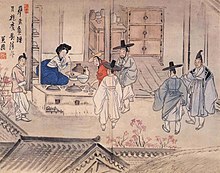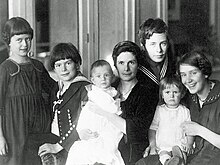푸하오 무덤
Tomb of Fu Hao푸하오 무덤(간단한 중국어: 妇好墓; 전통 중국어: 婦好墓; pinyin: F h Hǎo Mù)는 중국 허난성 안양시 내에 있는 고대 상왕조 수도 인의 유적지인 인수(仁水)에 있는 고고학 유적지다. 1976년 정전샹에 의해 발견된 이곳은 기원전 1200년경에 사망한 왕비 겸 장군 푸하오의 마지막 안식처로 확인되었으며, 우딩 왕과 그의 많은 부인들 중 한 명이 신탁 뼈에 새겨진 하오부인일 가능성이 높다.[1]
이 무덤은 그 내용물이 고스란히 남아 있고 고고학자들이 발굴한 유일한 샹 왕릉이다.[2] 발굴은 중국사회과학원 고고학연구소 안양실무팀이 맡았으며, 대대적인 복원 작업을 거쳐 1999년 일반에 공개되었다.
검색 및 내용

1976년 정전샹과 그녀의 고고학 팀은 뤄양 삽이라고 불리는 긴 삽으로 인수 주변을 조사하고 있었고, 붉은 옻칠의 샘플 몇 개를 회수했다.[4] 공식적으로 5호 무덤이라고 명명된 발굴된 무덤은 왕실 묘지 바로 바깥에 가로 5.6m, 세로 4m의 단일 무덤이다. 이 무덤은 기원전 1200년 경으로 추정되며, 의식용 동상에 새겨진 글에서 푸하오의 무덤으로 확인되었다.[5][6]
작은 무덤 중 하나인 그녀의 무덤은 가장 잘 보존된 상왕조 왕릉 중 하나이며 발굴 전에 약탈되지 않은 유일한 무덤이다.[1] 구덩이 안에는 길이 5m, 너비 3.5m, 높이 1.3m의 나무로 된 방이 있었는데, 그 뒤 완전히 썩어 버린 옻칠한 나무 관이 들어 있었다.[7]
마루 바닥에는 왕실 시체와 함께 묻힌 대부분의 기구와 기구들이 들어 있었다. 량주 문화의 것과 같은 희귀한 제이드 유물은 아마도 푸하오에 의해 골동품으로 수집되었을 것이며, 청동 유물의 일부는 무신이라는 그녀의 사후 이름이 새겨진 부인과 그녀의 집에 의해 사용되었을 것이다.[8] 무덤 안에서 출토된 유물은 다음과 같이 구성되었다.
- 755점의 옥물(룽산, 량주, 훙산, 시자허 문화재 포함)[9]
- 564개의 뼈 물체(헤어핀 500개와 화살촉 20개 포함)
- 청동그릇 200여 점,[10] 무기 130여 점, 종 23점, 칼 27점, 거울 4점, 호랑이 조각상 4점 등 청동 유물 468점.[11]
- 63개의 석물
- 도자기 11점
- 5개의 상아 물체
- 소가죽 6,900개(상나라 때 화폐로 사용)
시신 아래에는 6마리의 희생견 유해를 안고 있는 작은 구덩이가 있었고, 가장자리에는 인간 희생의 증거인 16명의 인간 노예의 해골이 놓여 있었다.[1]
또한 무덤 위에 세워진 구조물 위에 제사를 지내는 데 조상 전실 역할을 했을 것이라는 증거가 있는데, 이것은 그 후 복원되었다.[12]
양식적, 기술적 분석을 통해 푸하오 무덤의 옥 공예품을 훨씬 이전의 유물과 연결시킴으로써, 고고학적 맥락에서 초기 수집가, 즉 훨씬 이전 시대의 유물에 대해 모였던 한 여성이 확인되었다.[13]
참고 항목
- 기원전 433년으로 거슬러 올라가는 쩡 후작의 무덤은 중국의 주요 왕릉이 온전하게 발견되었다.
참조
| 위키미디어 커먼즈에는 푸하오 무덤과 관련된 미디어가 있다. |
- ^ a b c Ebrey, Patricia (2006). The Cambridge Illustrated History of China. Cambridge University Press. pp. 26–27. ISBN 0-521-43519-6.
- ^ Barbieri-Low, Anthony (January 30, 2010). "Fu Hao". Grove Art Online. doi:10.1093/gao/9781884446054.article.T097476. Retrieved March 10, 2018.
- ^ Buckley Ebrey, Patricia; and assistants. "FU HAO'S JADES". depts.washington.edu.
- ^ "An Yang, ancient capital of the Shang dynasty". China Central Television. Retrieved August 6, 2007.
- ^ "The Tomb of Lady Fu Hao" (PDF). British Museum. Retrieved August 4, 2007.
- ^ 키틀리, 데이비드 N. "중국에서의 예술, 조상, 글쓰기의 기원", 대표 (제56호, 특별호: The New Erudition, 1996: 68-95. 76페이지.
- ^ Buckley Ebrey, Patricia. "Shang Tomb of Fu Hao". A Visual Sourcebook of Chinese Civilization. University of Washington. Retrieved August 4, 2007.
- ^ "Excavations at the Tomb of Fu Hao". Teaching the Golden Age of Chinese Archeology. National Gallery of Art. Archived from the original on 2007-08-18. Retrieved August 4, 2007.
- ^ Buckley Ebrey, Patricia. "Jade from Fu Hao's Tomb". A Visual Sourcebook of Chinese Civilization. University of Washington. Retrieved August 4, 2007.
- ^ 로슨, 제시카(에드). 대영박물관서, 2007년 페이지 33, (제2회) 대영박물관출판, ISBN 9780714124469
- ^ Buckley Ebrey, Patricia. "Bronzes from Fu Hao's Tomb". A Visual Sourcebook of Chinese Civilization. University of Washington. Retrieved August 4, 2007.
- ^ "Lady Hao's Tomb in the Yin Ruins". The Garden Museum of Yin Ruins.
Lady Hao's Tomb was a tomb of the royal family of the Yin Dynasty, which was excavated by Anyang Working Team of the Archaeological Institute of the Chinese Social Science Academy in 1976. There was a house foundation remained from the Yin Dynasty on the tomb, which was restored to be the Memorial Hall for Lady Hao during the construction of the garden museum. The coffin chamber of the tomb under the house foundation was in the shape of a small shaft with many kinds of funerary objects buried in 7 layers. There were over 1,900 pieces of objects unearthed from the tomb, including bronze vessels, jade objects, gem objects, bone implements, potteries and so on. In addition, there were over 6,880 cowry-shells as well. The coffin chamber of Lady Hao's tomb was restored in 1999. According to the epigraphs on the bronze vessels and the shapes of the objects and referring to the records concerned in the oracular inscriptions, the occupant of the tomb should be the concubine Lady Hao if the King Wuding of the Yin Dynasty. Lady Hao was the earliest woman general in China, died in the period of Wuding and was given a name of temple as Xin after her death. The discovery of Lady Hao's tomb is of important value to the research of politics, economy, culture and art, small states around, rural system, dating of the bronze vessels, ancient science and technology and so on of the Yin dynasty.
- ^ Cuno, James (23 May 2012). Whose Culture?: The Promise of Museums and the Debate over Antiquities. ISBN 978-1400833047. Retrieved 2014-02-23.
추가 읽기
- Thorp, Robert L. (1981). "The Date of Tomb 5 at Yinxu, Anyang: A Review Article". Artibus Asiae. 43 (3): 239–246. doi:10.2307/3249839. JSTOR 3249839.
외부 링크
- 무덤의 웹사이트
- 10분짜리 다큐멘터리 특집, 7부 1편
좌표: 36°7′15.71″N 114°18′58.34″E / 36.1210306°N 114.3162056°E





